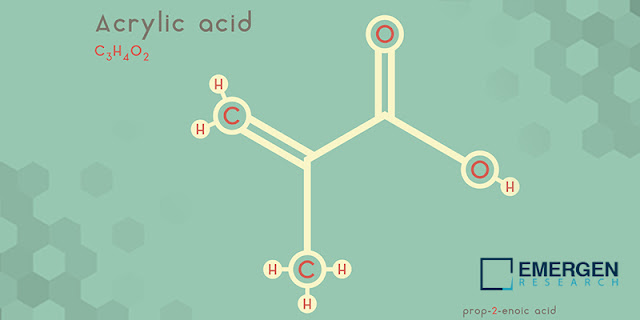Acrylic acid is a bulk chemical and is widely used in
water-based acrylic resins in the form of acrylate esters. Acrylic acid and its
salts and esters are key basic materials used for the superabsorbent, adhesive,
and paint coating industries. In conventional method, acrylic acid is manufactured
by a catalytic two-step gas-phase oxidation of propylene with a global
production of more than five million tons annually. One of the major drawbacks
of this route is the increased dependency on non-renewable fossil resources.
Over the recent past, growing efforts to reduce carbon emissions and increasing
concern regarding rapid depletion of fossil fuel resources have led the
chemical companies and overall industry to search for and examine alternative
route for bio-based feedstock for production of acrylic acid. Growing focus has
been put on using renewable biomass feedstock as a basis for sustainable and
large-scale production of bio-based
acrylic acid.
Petrochemical based polymers, coatings, and paints are
crucial to modern day society but increasing focus on sustainability have
increased demand for greener processes and renewable feedstock materials. In
recent years, significant research and development activities have been carried
out for manufacturing acrylic acid from natural renewable sources such as
lactic acid, glucose or molasses made from biomass, and glycerol. Advances
towards bio-based acrylic acid originating from 3-hydroxypropionic acid,
glycerol, lactic acid, and acrylonitrile highlight the importance of novel
sustainable building blocks. Recently a breakthrough research study was
published in the journal Angewandte Chemie International Edition that reported
a sustainable functionalization of acrylic acid towards various acrylate
derivatives through a one-pot catalytic transformation using biobased alcohols.
The research was carried out to develop a green synthetic route to acrylic acid
from biomass using furfural through sequential photochemical and catalytic
oxidations with air and ethenolysis as major steps with hydroxybutenolide and
maleic anhydride as key intermediates.
Request Free Sample Copy (To Understand the Complete
Structure of this Report [Summary + TOC]) @ https://www.emergenresearch.com/request-sample/992
In May 2020, Cargill, Inc. announced it would be using
developed by Procter & Gamble to revive its long-term efforts to produce
bioacryclic acid using corn dextrose as feedstock. Procter & Gamble
scientists have developed a production route based on lactic acid that Cargill
already produces from corn at its manufacturing facility in Nebraska, United
States, majorly as a raw material for the polymer polylactic acid. Procter
& Gamble converts lactic acid to acrylic acid using a dehydration catalysts
that is made of metal-containing phosphate salts. Cargill has an exclusive
license to utilize the technology for the production of bio-based acrylic acid.
One of the major consumer of bio-based
acrylic acid is the superabsorbent polymers used in the manufacturing of
diapers. Consumer demand for sustainable diapers compelled Procter & Gamble
to develop biobased chemistry and search for a large-scale manufacturer.
Another Massachusetts-based technology company, KSE
Inc., is engaged in developing a technology that can convert crude glycerol –
which is produced as the primary byproduct of biodiesel manufacture – into
acrylic acid. In 2019, LG Chem and ADM announced a joint development agreement
(JDA) to secure mass production technology to develop biobased acryclic acid
that can be used in the manufacturing of superabsorbent polymers that are used
in diapers and other hygiene products.
In a recent research study, published in 2021,
researchers found lignocellulosic biomass as a promising feedstock for the
sustainable manufacturing of biofuels and bioproducts, particularly
3-hydroxypropionic acid as a platform chemical to produce important chemicals
such as acrylic acid. The study leveraged BioSTEAM platform to design,
simulate, and evaluate biorefineries producing acrylic acid by fermentation of
sugars to 3-hydroxypropionic acid.
Key companies in the bio acrylic acid market include ASF
SE, China Petroleum & Chemical Corporation (SINOPEC), Arkema S.A.,
Mitsubishi Chemical Holdings Corporation, The Dow Chemical Company, The
Lubrizol Corporation, Evonik Industries AG, PTTGC Innovation America
Corporation, Formosa Plastics Corporation, and SIBUR International GmbH. In
February 2022, BioMADE, which is the Bioindustrial Manufacturing and Design
Ecosystem, announced USD 12.1 million for 16 projects to accelerate
bioindustrial manufacturing in the United States including developing chemicals
such as bio acrylic acid and succinic acid.
Custom Requirements
can be requested for this Report [Customization Available] @ https://www.emergenresearch.com/request-for-customization/992




No comments:
Post a Comment